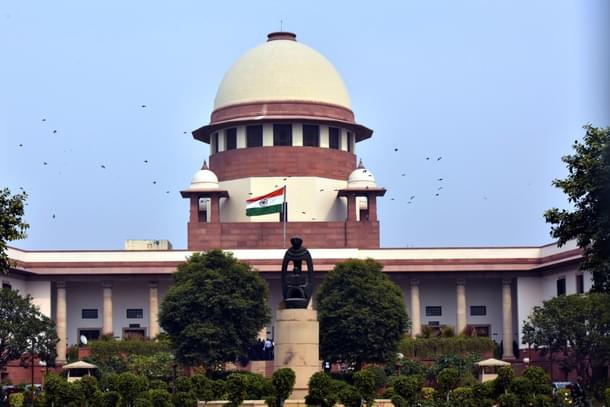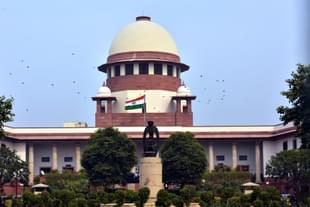Politics
SC/ST Sub-Classification: Supreme Court’s Ruling Hits All The Right Notes
Ananth Krishna
Aug 16, 2024, 02:34 PM | Updated 02:34 PM IST
Save & read from anywhere!
Bookmark stories for easy access on any device or the Swarajya app.


The recent Supreme Court judgement permitting states to undertake sub-classification of SC/STs (Scheduled Castes/Scheduled Tribes) has hit all the right notes and advances the original intention of the framers in reservation in public employment and education.
This decision has already been subject to a social media firestorm, and National Democratic Alliance (NDA) ally Lok Janshakti Party (LJP) has already announced that it will approach the Supreme Court for a review petition, with Bahujan Samaj Party supremo Mayawati also opposing the judgement.
There is also a significant controversy on Justice Bhushan Ramkrishna Gavai’s observation about the need to bring about a ‘creamy layer’ among the SC/ST categories, and no doubt it has gotten the greatest amount of pushback.
And through all this, both the Bharatiya Janata Party (BJP) and Congress have by and large maintained a silence nationally about the judgement and its repercussions. In fact, the only comment made by the BJP-led government was on 9 August to say that the ‘creamy layer’ would not be applied to SC/ST categories on the basis of the judgement.
This might be the most politically feasible option that does not rock the boat, especially considering that NDA allies have come out against the broader judgement itself. Yet, the discourse that the court has initiated on this issue is much needed, though it does show lack of judicial discipline.
A Background Of The Case
Sub classification of SC/ST groups have been attempted by various state governments over the years. The first instance that ended up in court was the attempt by the Andhra Pradesh government under Chandrababu Naidu in 2000 to sub-classify the SC groups in the state.
The move was a result of the prolonged efforts by the Madiga community, but the move was challenged by Mala, another SC group in the state, in the High Court. While the High Court upheld the state legislation, the Supreme Court in a five bench decision struck it down in E V Chinniah versus State of Andhra Pradesh (2005).
But this did not deter other state governments from creating SC sub-quotas, with Tamil Nadu enacting 1 per cent sub reservation for the Arunthathiyar community in the state in 2008, and the Punjab government passing a legislation for ‘first preference’ in the SC quota in 2010. It is the latter of which ended up in the Supreme Court in 2014, eventually leading to the current decision.
The decision that Chinniah deserved a re-look came from a five-bench decision, in which Justice Arun Mishra’s judgement disagreed with the rationale of Chinniah. The court essentially framed two questions that a seven-judge bench were to answer:
1. Was the Scheduled Caste/Tribe classification a homogenous classification; ie, no sub-classification could be permitted among them; or were they a heterogeneous grouping under Article 341 and 342, ie, they can be sub-classified? And;
2. Whether states have the power to undertake sub-classification if it is constitutionally permissible?
These were the questions that the court broadly answered in its judgement on 31 July.
SCs Are Not A Homogenous Classification
The most important context in understanding the judgement is that homogenous groups cannot be classified among themselves as this will fall foul of Article 14, which guarantees ‘right to equality’.
In terms of jurisprudence, the court has over the years made it clear that Article 14 is about treating equals equally. That means that if a group were deemed to be homogenous, then persons within the group cannot be treated differently.
So, if Scheduled Castes were a uniform, homogenous group or have been deemed so through their inclusion in the list, then sub-classification would not be possible.
Now it is apparent socially speaking that Scheduled Castes are not on the same plane; and the main judgement by Chief Justice D Y Chandrachud too finds this to be the case. He points out the internal hierarchy among SCs as well as evidence of caste based attacks between SC groups to show that to call all the groups classified as “SC” under Article 341 to be a stretch.
Being classified as SC under the Constitution only entitles the group to benefit from that classification, and does not ‘create’ a homogenous class as per CJ Chandrachud.
This means that as per the terms of Article 14, sub-classification is possible.
In the question of states power to sub-classify, the court’s assessment was that the power for this came from articles 15 and 16 which allows the ‘state’ to classify groups for the purpose of benefits in public employment and education.
The four concurring opinions in the judgement are in broad agreement with this assessment by the CJI; but what was clearly tangential to the issue had been picked up by Justice Gavai in his concurring opinion, the question of creamy layer among SC/STs.
Creamy Layer Among SC/STs: Necessary; But Beyond Scope Of Legal Question
The concurring opinion by Justice Gavai more or less goes along the lines of the observations of the Chief Justice's judgement, but where he diverges is on the issue of creamy layer. While the Chief Justice’s judgement does touch up on the issue of creamy layer, it is strictly in the context of the earlier decisions of the court.
Justice Gavai however makes it a major topic in his opinion, tracing out the rationale of creamy layer as was applied in Indra Sawhney versus Union of India (1992) which upheld the implementation of Mandal Commission recommendations. He questions whether a similar rationale does not exist to apply ‘creamy layer’ in SC/ST:
“The question that will have to be posed is, whether equal treatment to unequals in the category of Scheduled Castes would advance the constitutional objective of equality or would thwart it? Can a child of IAS/IPS or Civil Service Officers be equated with a child of a disadvantaged member belonging to Scheduled Castes, studying in a Gram Panchayat/Zilla Parishad school in a village?”
This is the broad rationale that Justice Gavai has for arguing in favour of creamy layer among SCs. He does however note that the criteria for this cannot be similar to the creamy layer among Other Backward Classes (OBCs), considering their more disadvantaged position compared to them.
These observations are welcome; as it recognises that the percolation of benefits of reservation should not be limited to an elite among the SC/ST community that has been able to secure intergenerational benefits of reservation.
This is no doubt an extension of the observation that SC groups are homogeneous; even within a group there are definite differences between those better off economically.
Creamy layer in SC/STs is a logical response to the real and apparent differences among those who have benefited from affirmative action or from economic advancement. To say that it does not confer any social advancement whatsoever is ignorant.
That being said, it would have to be mentioned that the discussion of topic by Justice Gavai is a reflection of lack of judicial discipline; this question of creamy layer did not arise in the case; at best it is tangential. But he has made it a centrepiece of his judgement. That three other judges (justices Mithal, Sharma and Nath) agreed with it does not make it any more acceptable.
It should also be noted that the entire debate on creamy layer and advancement of SC/ST categories must be tempered by the fact that posts higher up the ladder go unfilled. This is a reflection of the structural problems affecting the advancement of the SC/ST communities to which mere affirmative action is not the answer.
Obviously, there is more context to this considering the Supreme Court’s long-standing interventions on the issue of reservation in promotion.
Since the central government had already rejected the idea of creamy layer in promotion, and considering the political landmine it could open up if it were to back it in reservation, that the Narendra Modi government comprehensively rejected the idea in a recent cabinet meeting is not surprising.
While Justice Gavai’s observations were not strictly within the realm of the questions asked, it has started a much needed discourse on the issue of creamy layer among these groups. Hopefully in a different political climate and circumstance, the topic is broached in a more conducive manner.
The author would like to thank Monalisa Nanda for her inputs.
Ananth Krishna is a lawyer and observer of Kerala's politics.





